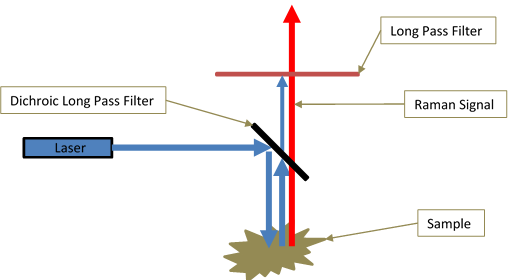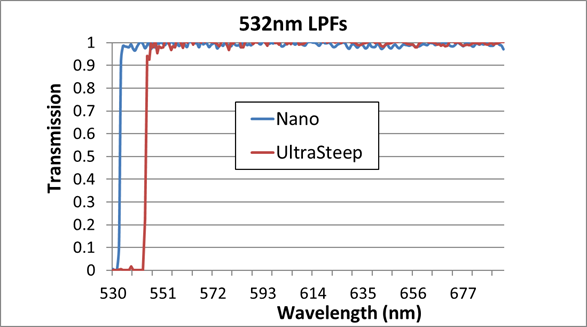Raman spectroscopy is a robust and highly versatile analytical tool that can determine the molecular constituents of to-be-tested samples. In combination with microscopy, it can be used to explore particular cellular structures and functions.
Raman spectroscopy is non-contact, non-invasive, and does not require any chemical tagging or sample preparation. These aspects have made it an invaluable analytical technique not only in labs but also in the field.
Raman scattering is defined by the transfer of energy between photons and vibrational modes of molecules, which occurs for about one in a million incident photons. Such a transfer in energy between the incident photon and molecule leads to a shift in the wavelength of the Raman scattered photon with respect to the excitation wavelength. This shift could be a “Stokes” shift to longer wavelength and lower energy, or it could be an “anti-Stokes” shift to shorter wavelengths and higher energy.
This event has a low probability, making detection informative yet evasive, Raman scattered signal from the dominant Rayleigh scattered photon signal much more challenging. Optical filters play a crucial role in overcoming this drawback. The dominant Rayleigh scattered light wavelength can be blocked by using selective optical filters, thus transmitting only the Raman scattered photons, thereby providing “more signal, with less background” to the detector.
However, optical filters of different types are needed to strike a balance between the commercial (cost and supply) and technical (performance) requirements of different applications and markets.
This helps achieve a balance between filters with smaller cutoff values and steeper slopes for state-of-the-art technical performance but at a higher cost. Therefore, another class of filters with lower cost, wider angle tolerances, and larger cutoff values—that facilitate the use of inexpensive laser sources and compact, cost-effective optics used in low-cost, high-volume instruments to clearly detect the molecules—is being investigated.
Details Matter—High-Precision Raman
It has been found that Raman analysis has the potential to find the molecular composition of various unknown chemicals such as drugs and pharmaceuticals (together with their counterfeits). High-precision analytical laboratory tools like Confocal Raman Microscopes, which are crucial in research settings, can be used to observe the signature Raman spectral “fingerprints” of chemical species.
Yet, most of the details that render the identification of this molecular species possible involve small energy exchanges between the incident and Raman scattered photons. Thus, it is essential to detect the Raman signals extremely close to the laser line wavelength to gain access to this “fingerprint” region of the Raman spectrum. This thus necessitates highly steep edge pass filters with precise “cutoff” wavelength positions filtering.
“Cutoff” can be defined as the spectral shift in wavenumbers (cm−1) between the 50% transmission point and an optical density blocking of six orders of magnitude at the laser line wavelength (OD >6 or <0.0001% of the laser line power). In this fingerprint region, crucial spectral information can be found within a cutoff of 25–50 cm−1, which defines the need for detection in the Raman instruments.
This poses various challenges for manufacturers of optical filters. Firstly, it is crucial for a filter to be engineered with an adequately steep edge slope to achieve such a very low cut-off value in theory. For this, filter designs with hundreds of tightly controlled individual dielectric layers or more could be needed.
Moreover, even if a filter is engineered and produced with a sufficiently steep edge slope, the wavelength uniformity and targeting over the part size (which usually ranges from 12.5 mm to 25 mm) pose challenges in manipulating the manufacturing processes to such a level of wavelength precision in a manufacturable, repeatable way to practically achieve this performance.
Is it this or is it that? Handheld “In-Field” Raman
Rather than attempting to detect entirely unknown materials from their chemistry or employing Raman microscopy to analyze material structures, Raman’s robust capability to quickly, non-invasively identify molecules and without the need for sample preparation has led to a surge in the demand for handheld Raman analytical devices designed to identify molecules from a smaller library of possibilities.
Such portable precision devices feature small desktop instruments employed in applications like airport liquid screening, instruments with handheld probe attachments for dock-to-stock analysis of incoming goods like pharmaceutical shipments in barrels, and handheld devices that can quickly detect, identify precursor chemicals, raw materials, illicit drugs, explosives, additives, gemstones, veterinary drugs, and residues of pesticide.
To offer the flexibility required in “real-world” environments, this class of Raman instruments must have the capability to scan the materials with a wider incident angle of light (AOI) and potentially an uncollimated cone half-angle (CHA). As a result, the instruments must have the ability to accept higher wavenumber and higher cut-off values for the detected Raman signal (a wider passband wavelength range for the filter), for example, more than 250 cm−1 from the laser line.
In general, extended operating ranges are additionally needed, which pushes the transmission band to longer wavelengths, for example, up to 1420 or 1770 nm (the lab units often only work between 300 and 1200 nm because of the Si detectors used with them).
Such wider operating conditions pose various filtering challenges beyond those mentioned above. Although the complexity of the filters is less with respect to the layer count for the Raman edge-pass (due to the lower steepness), they must have controlled cut-off values to be able to support the wider angle ranges of use together with wider and deep blocking ranges.
Moreover, these filters are much more cost-effective as the instruments in which these are used can be somewhat less costly compared to their laboratory counterparts and they must be able to be passively combined into the instrument (that is, with minimal manual alignment). This is because their constructions are voluminous.
Optical Filter Solutions
Evidently, a wider range of optical filter solutions is required to meet the needs of these to related yet highly distinct market applications.

Iridian has introduced a range of ultra-steep (US) long pass edge and “nano-edge” long pass filters (LPFs) to meet the demands of high-precision Raman instruments. The cutoff values of the US LPFs range from 40 to 50 cm−1, while the cutoff values of the “nano-edge” LPFs vary from 25 to 38 cm−1.
These steep LPF filters are steep by nature, necessitating the system setup of the end-user to have stringent controls on AOI with a well-known laser line wavelength and a highly collimated input laser beam to take optimally leverage the low cutoff values that these filters have been engineered to deliver.

The wide-angle long pass filters (WA LPF) available from Iridian are the desired solution for customers’ devices and instruments that have wider AOI ranging from 0°–2°, offer extended passband wavelength range with transmission > 93%–95%, CHA of up to 5°, and extended blocking wavelength range with OD6 blocking across the wider operating ranges of such devices.
| LPF types |
Laser Line [nm] |
AOI Range [degree] |
CHA [degree] |
Cutoff [cm-1] |
Blocking range [nm] |
Pass Band Tx > 93% Range [nm] |
Blocking (Optical Density) |
| Nano |
785 |
0 |
0 |
26 |
785 |
789-1200 |
OD 6 |
| US |
785 |
0-1 |
0.1 |
40 |
785 |
790-1200 |
OD 6 |
| WA |
785 |
0-2 |
5 |
105 |
650-786 |
792.5-1200 |
OD 6 |
In general, dichroic filters are often used in the Raman probe and spectrometer systems. Here, they serve the purpose of reflecting the laser to the sample and as first edge pass filter in combination with the second edge pass filter in the instrument. Consequently, the dichroic used in such cases must also cover the extended transmission bands for the receiving signals.
In Raman systems of both types, narrow laser line filters are used to clean-up the excitation source and prevent any secondary peaks from influencing the to-be-tested sample. It is essential for these narrow bandpass filters to be engineered to pass the laser line while making sure that the blocking is in alignment with the transmission band of the selected edge pass filter to eliminate leakage of the laser light into the detection path.
Although there is a wide range of off-the-shelf standard filter solutions, it is vital to make sure that the ideal filter is selected for the right task to improve the technical performance and reduce the price for performance. In general, custom filter solutions (or personalized versions of standard solutions) can be the ideal choice specifically for OEM instruments with volumes ranging from tens to hundreds of units.
Customers can seek the help of optical filter vendors as collaborators or partners to help design and recommend the most ideal solution for a specific need, thereby enabling the optimizations and trade-offs to be designed and considered in early, which not only saves time and money but also optimizes the Raman signal output.

This information has been sourced, reviewed and adapted from materials provided by Iridian Spectral Technologies.
For more information on this source, please visit Iridian Spectral Technologies.